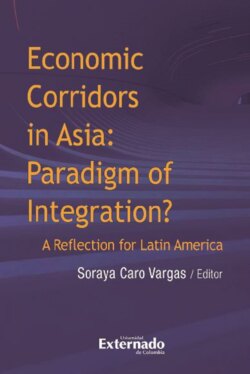Читать книгу Economic corridors in Asia : paradigm of integration? A reflection for Latin America - Varios autores - Страница 5
На сайте Литреса книга снята с продажи.
CONTENIDO
ОглавлениеFOREWORD
INTRODUCTION
Soraya Caro Vargas
1.The History of a Multicultural Academic Endeavour
2.The Search for Security vs. Growing Uncertainty
2.1.Methodology and Techniques
3.Theoretical Markers
4.Bibliographic antecedents in the Region and the Relevance of this Initiative
5.Globalizing Precursors and the Resurgence of the Economic Corridor as a Term and Consequence of BRI
6.On the Authors and their Vision of Corridors and BRI
Conclusion
References
1. LA NUEVA RUTA DE LA SEDA: CONTEXTO HISTÓRICO Y ASPECTOS GEOPOLÍTICOS DE LA ESTRATEGIA GLOBAL DE CHINA
Alexánder Arciniegas Carreño
Resumen
Abstract
Introducción
1.Los cambios en la inserción internacional china y la emergencia de Obor
2.Los caminos de la Ruta de la Seda: franja terrestre y ruta marítima; naturaleza, principios, ejes de actuación e institucionalidad
3.Asia central: recursos e importancia estratégica para China
4.Obor el dilema de India
5.Algunas consideraciones conclusivas sobre la proyección internacional de China y su impacto en Latinoamérica y Colombia
Referencias
2. INDIA’S ECONOMIC CORRIDORS AND SUB-REGIONAL CONNECTIVITY: CHALLENGES AND PROSPECTS
Pankaj K Jha
Abstract
Resumen
Introduction
1.Theoretical Discourse about Economic Corridors
2.India’s Economic Corridors and Highway Networks
3.Developing Port Infrastructure
4.River Interlinking Plan and Promotion of Inland waterways
5.Connecting with Neighborhood and Sub-Regional networks
6.Trilateral Highway Networks-Myanmar-India- Thailand
7.Mekong India Economic Corridor (MIEC)
8.Indo-Pacific Economic Corridor (IPEC)
9.Transport Corridors –BBIN and BCIM initiative
10.Structural Constraints and Bottlenecks
Conclusion
References
3. CHINESE CAPITAL FLOWS TO AFRICA IN A CONTEXT OF THE SILK ROAD
Alicia Girón
Abstract
Resumen
Introduction
1.Theoretical perspective
2.Behavior of Financial Flows from Chinese Banks and Companies in Africa
3.Constant Growth of the Process of Indebtedness since the Post-Crisis Period
4.Concluding remarks: Challenges facing Africa in the face of financial flows
References
4. DEVELOPMENT CORRIDORS IN AFRICA: FOREIGN POLICY AND REGIONAL INTEGRATION STRATEGIES IN THE GLOBAL SOUTH
Jerónimo Delgado Caicedo
Juliana Andrea Guzmán Cárdenas
Abstract
Resumen
Introduction
1.Development corridors
1.1.From transport corridor to economic corridor
1.2.Development corridors and Africa
2.Development Corridors as a Foreign Policy and Regional Integration Tool
2.1.Foreign Policy in the Global South
2.2.African Regional Integration
3.Challenges
4.Conclusions
References
5. A CRITICAL DISCOURSE ANALYSIS OF THE CHINA-PAKISTAN ECONOMIC CORRIDOR. MAPPING PUBLIC DISCOURSE IN PAKISTAN: THE CASE STUDY OF THE INSTITUTE OF STRATEGIC STUDIES
Ahmad Saffee
Abstract
Resumen
Introduction
1.Situational Analysis of Geo-political Environment
2.Theoretical Framework
2.1.Critical Discourse Analysis (CDA)
3.Research Methodology
4.Research Analysis – A Critical Thematic Analysis of Discourse
4.1.The Communist Party of China
4.2.Media and Think Tank Community
Conclusion
References
6. RESURGENCE OF SOUTH-SOUTH COOPERATION AND CHINA’S BELT AND ROAD INITIATIVE IN ASIA AND LATIN AMERICA
Ume Farwa
Ghazanfar Ali Garewal
Abstract
Resumen
Introduction
1.Belt and Road as a Project of South-South Cooperation
2.China-Pakistan Economic Corridor: China as a Locomotive and Pakistan as a Catalyst
3.The Good and the Best
4.The Fix
5.Looking Forward: Lessons for Latin America and Impact on SSC
Conclusion
References
7. THE INFRASTRUCTURE GAP IN LATIN AMERICA AND THE ARRIVAL OF CHINESE INFRASTRUCTURE FIRMS: SPECIAL REFERENCE TO THE ARGENTINIAN CASE
Leonardo E. Stanley
Abstract
Resumen
Introduction
1.The nature of the firm (or Why Chinese firms are something special that should be considered)
2.The Belt and Road Initiative and Latin America Infrastructure Gap
3.Industry Analysis (with a focus on the Argentinean case)
3.1.Argentina Infrastructure Gap (particular emphasis on roads)
3.2.The entry of Chinese firms and local business groups: competition or cooperation
3.3.Financial Schemes and Governance Issues
4.Conclusions
References
8. EL MERCOSUR EN LA BÚSQUEDA DE ASIA PACÍFICO
Gustavo Cardozo
Resumen
Abstract
Introducción
1.La Nueva Ruta de la Seda y su impacto en América Latina y el Caribe: perspectivas desde el Cono Sur
2.El Mercosur en la búsqueda de Asia Pacífico
Conclusiones
Referencias
9. DEL FORTALECIMIENTO DE LAS FRONTERAS A LA CONECTIVIDAD: LECCIONES PARA EL SUR DE ASIA Y AMÉRICA DEL SUR
Kelly Arévalo
Resumen
Abstract
Introducción
1.Más allá de la geografía política
2.Conectividad hoy: corredores económicos
3.Conectividad en el Sur de Asia
4.Conectividad en América del Sur
5.Conclusiones
Referencias
10. EL SUDESTE ASIÁTICO EN LAS NUEVAS RUTAS TRANSCONTINENTALES ASEAN
Pío García
Resumen
Abstract
Introducción
1.Asean en el núcleo de la integración asiática
2.Asean en los proyectos transcontinentales asiáticos
3.Asean frente a los proyectos transcontinentales: impacto y perspectivas
4.Asean, las rutas transasiáticas y América Latina y el Caribe
Conclusiones
Referencias
11. THE ROLE OF THE CENTRAL ASIAN REGION IN CHINA’S NEW SILK ROAD ECONOMIC BELT PROJECT
Azhar Serikkaliyeva
Abstract
Resumen
Introduction
1.China’s Interests in Central Asia
1.1.The SCO: Fighting three evils
1.2.Energy
1.3.China’s Peaceful Co-development and Good Neighborly Policy
2.Situating Central Asia in BRI
2.1.Why Central Asia is important for BRI?
2.2.Main BRI projects in Central Asia
2.3.The New Eurasian Land Bridge
3.Economic corridor China - Central Asia - Western Asia
3.1.Response from Central Asia: case of Kazakhstan
Conclusion
References
12. TURKEY AND THE BELT AND ROAD INITIATIVE
Gökhan Tekir
Abstract
Resumen
Introduction
1.Baku-Tbilisi-Kars Railway
2.Turkey’s Domestic Railway Lines
3.Marmaray and Yavuz Sultan Selim Bridge
4.The Turkish Maritime Leg of the Belt and Road
5.Turkey’s Role in Civilizational Connectivity
6.Challenges to Turkey’s Participation in the Belt and Road Initiative
6.1.Volatility in the Infrastructure Sector
6.2.The Xinjiang Problem
Conclusion
References
13. BELT & ROAD INITIATIVE Y SU SIGNIFICADO GEOPOLÍTICO PARA CHINA Y ASIA CENTRAL
Diana Andrea Gómez
Resumen
Abstract
Introducción
1.Alcance del BRI
1.1La tecnología rebasa la geografía
2.Importancia geopolítica de BRI
2.1.BRI en perspectiva doméstica
2.2.BRI en perspectiva regional: el rol de Asia central
3.Grandes desafíos generados por BRI en perspectiva global
3.1.El rol central de las ciudades
Conclusiones y recomendaciones
Referencias
REFLEXIONES FINALES E INVITACIÓN A LA ACADEMIA
Soraya Caro Vargas
Referencias
NOTAS AL PIE
AUTHORS
